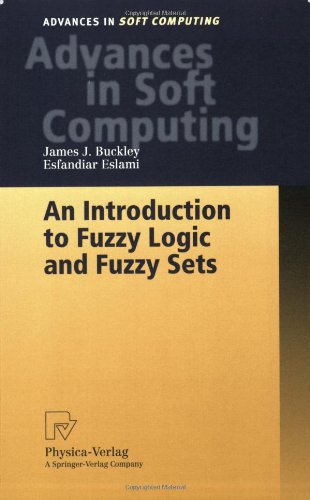Introduction Fuzzy Advances Intelligent Computing

Buckley and Eslami's notation and some of their ideas on fuzzy sets might go deeper than many others. I've found this book intriguing to say the least. You'll find this a very concise "no-nonsense" sort of math book. Ideas get explained in a few sentences or in a few paragraphs, and then come the exercises! And you'll find even more new ideas, not mentioned in the reading, in the exercises. I do like this sort of style of learning mathematics, because it actively gets you involved.
This book and others on fuzzy set theories do require a decent understaning of crisp set theory. So, if one hasn't taken a course or read a book on crisp set theory you might want to check out a copy of Seymour Lipschutz's Schaum's Outline "Theory and Problems of Set Theory." Knowing some basic calculus will also help. Some advantages of this book lie in that it helps one to separate the idea of fuzzy intersections and fuzzy unions from the standard and useful idea of t-norms and t-conorms. Sections on fuzzy geometry, fuzzy trignometry also seem interesting as these ideas have not yet gotten much development.
I think I've detected a potential error in the text in that it gives an integral for an equation that had to have had part of the integral as negative. But, this seems relatively minor. The book could easily get improved if the author(s) provided solved examples of their exercises, or at least answers. Something like a Schaum's Outline of Fuzzy Set Theory would be an excellent idea!
I appreciate simple things in this text like the authors not saying "prove this truth table..." and instead saying "prove or disprove...", and not saying "prove" in general, but rather saying "show".
Buckley and Eslami's notation and some of their ideas on fuzzy sets might go deeper than many others. I've found this book intriguing to say the least. You'll find this a very concise "no-nonsense" sort of math book. Ideas get explained in a few sentences or in a few paragraphs, and then come the exercises! And you'll find even more new ideas, not mentioned in the reading, in the exercises. I do like this sort of style of learning mathematics, because it actively gets you involved.
BalasHapusThis book and others on fuzzy set theories do require a decent understaning of crisp set theory. So, if one hasn't taken a course or read a book on crisp set theory you might want to check out a copy of Seymour Lipschutz's Schaum's Outline "Theory and Problems of Set Theory." Knowing some basic calculus will also help. Some advantages of this book lie in that it helps one to separate the idea of fuzzy intersections and fuzzy unions from the standard and useful idea of t-norms and t-conorms. Sections on fuzzy geometry, fuzzy trignometry also seem interesting as these ideas have not yet gotten much development.
I think I've detected a potential error in the text in that it gives an integral for an equation that had to have had part of the integral as negative. But, this seems relatively minor. The book could easily get improved if the author(s) provided solved examples of their exercises, or at least answers. Something like a Schaum's Outline of Fuzzy Set Theory would be an excellent idea!
I appreciate simple things in this text like the authors not saying "prove this truth table..." and instead saying "prove or disprove...", and not saying "prove" in general, but rather saying "show".
BalasHapus